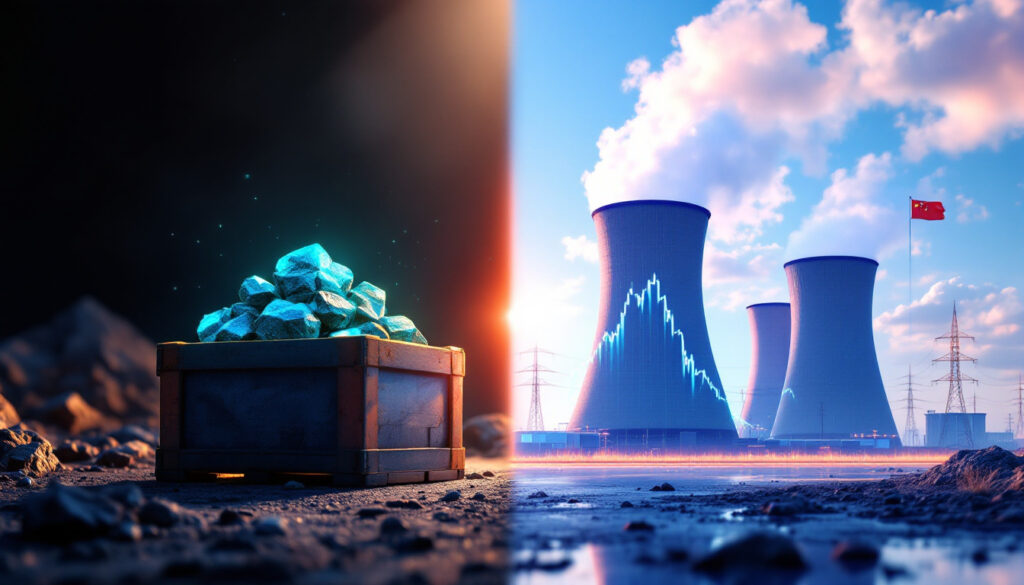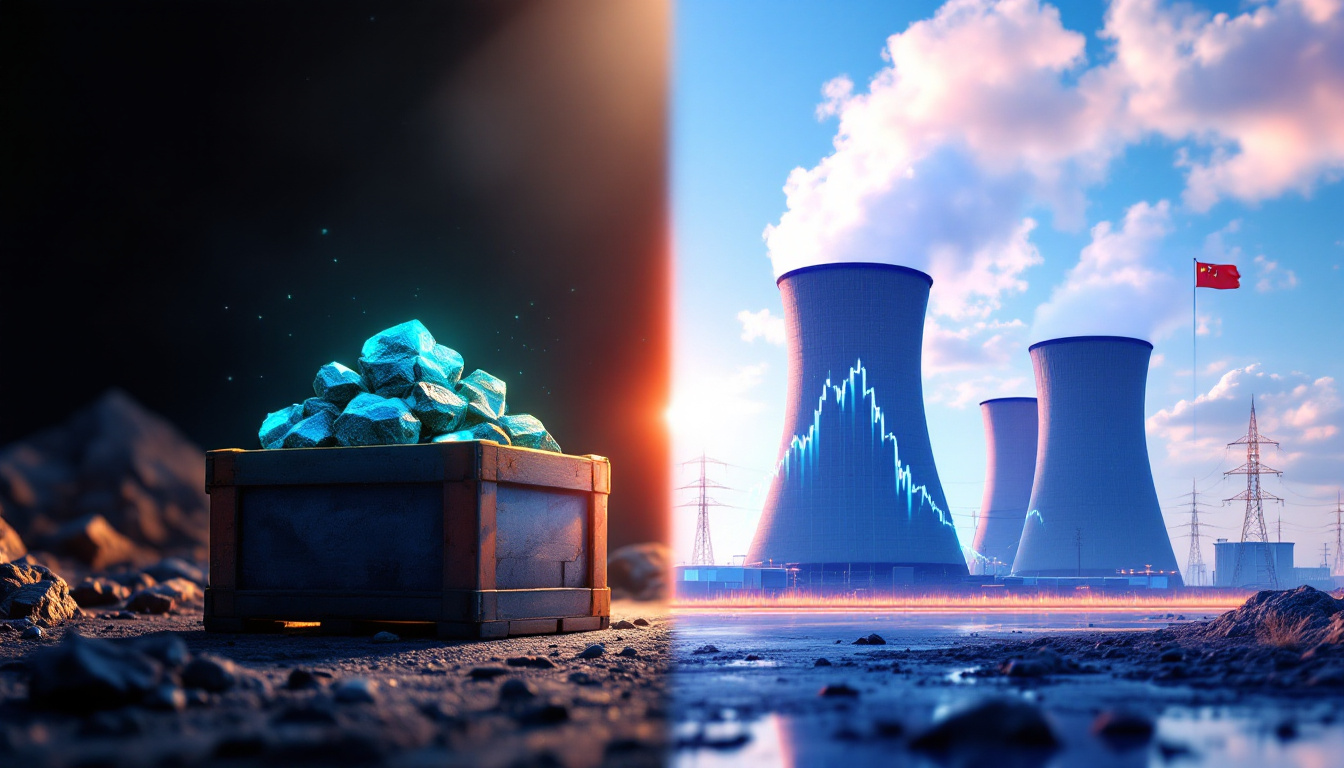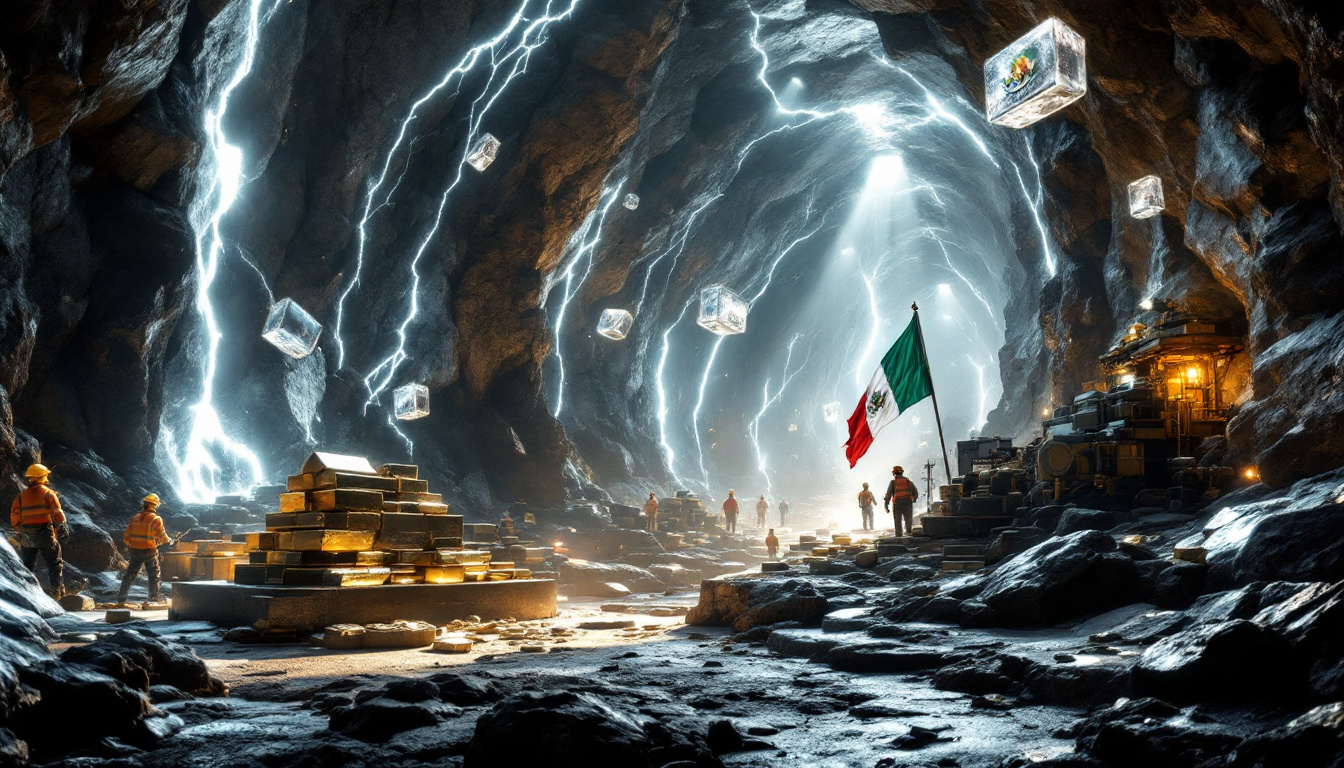What's Happening with Uranium Prices in 2025?
Recent Price Movements and Market Recovery
The uranium market has experienced remarkable uranium market volatility in 2025, with spot prices hitting a dramatic 17-year high of US$107/lb in January before experiencing a sharp correction to US$63.45/lb by mid-March. This 40% decline initially alarmed some investors, but the subsequent rebound to US$71.25/lb in May 2025 has reignited optimism. This 20% recovery from the March lows signals resilience in a market that continues to exhibit classic cyclical behavior.
Meanwhile, term contract prices have demonstrated notable stability, hovering consistently around US$80/lb for nearly 12 months. This price steadiness in the term market—where utilities secure long-term supply—contrasts with spot market volatility and offers a compelling indicator of underlying market strength.
Industry analyst Duncan Craib from Boss Energy remarked: "The term price stability reflects the true value utilities place on securing guaranteed future supply, which is becoming increasingly critical as more reactors come online."
The Spot vs. Term Price Dynamic
Understanding the relationship between spot and term prices provides crucial insights into the uranium market's health:
- Spot market pricing (currently US$71.25/lb) represents immediate delivery transactions
- Term contract pricing (stable at ~US$80/lb) covers multi-year utility agreements
- Price convergence is occurring as the gap between spot and term prices narrows
- Trading volume in the spot market has surged to an annualized rate of 10Mlb, a significant increase from the historical average of 3-5Mlb
Notably, utilities have become increasingly active in the spot market, purchasing approximately 75% of 2024's total spot volume in just the first half of 2025. This uptick in utility spot market activity often precedes a return to term contracting, as utilities test price levels before committing to long-term agreements.
"When utilities step into the spot market at this volume, it historically signals the early stages of a new contracting cycle. They're testing the waters before making longer commitments," notes John Borshoff, Managing Director of Paladin Energy.
Another significant market development is the reemergence of carry trades, with approximately 4Mlb traded in 2025. These trades—where material is purchased for delivery and simultaneous resale at a future date—indicate growing speculative interest in uranium's forward price trajectory.
Equity Performance vs. Commodity Prices
Uranium equities have demonstrated a more robust recovery than the underlying commodity:
- 19% rally in uranium stocks over the past month
- Year-to-date growth of 12% for producers and 15% for developers
- Equity valuations remain at "beginning-of-cycle" levels according to Canaccord Genuity
- Current stock prices haven't fully reflected the commodity price recovery
Historically, uranium equities tend to amplify both upward and downward movements in the commodity price. The recent equity outperformance suggests investors may be anticipating further uranium price strength beyond current levels.
The analysts at Canaccord Genuity have observed: "Uranium equities remain at historic discounts to long-term price forecasts. We believe this gap represents an opportunity as pressure builds for utilities to return to the contracting market."
This valuation gap presents potentially attractive entry points for investors who accept the long-term supply-demand thesis. Companies like Paladin Energy (ASX:PDN) with its restarted Langer Heinrich mine in Namibia and Boss Energy (ASX:BOE) with its Honeymoon project in South Australia exemplify producers positioned to capitalize on strengthening market fundamentals.
Why Are Analysts Bullish on Uranium's Future?
Supply-Demand Fundamentals Strengthening
Multiple structural factors are creating increasingly favorable conditions for sustained higher uranium prices:
- Primary supply fragility persists with limited new production facilities coming online despite price increases
- Chinese reactor construction continues at an unprecedented pace with 32 reactors currently under construction
- Western nations are implementing license extensions, extending nuclear facility lifespans to 80 years in many cases
- Global inventories have declined to the lowest levels in decades after years of production deficits
- Production costs have risen substantially, pushing the necessary incentive price for new mines toward US$100/lb
- Contracting activity remains below replacement rates, creating ongoing supply concerns
The supply gap appears particularly pronounced when examining capacity being retired versus new production coming online. According to World Nuclear Association data, the gap between projected demand and primary production capacity could exceed 60 million pounds annually by 2030 without significant new mine development.
Andrew Grove, CEO of Aura Energy, emphasizes: "The structural deficit in production should eventually reflect in the uranium price. We've seen continual delays in bringing promised production online, and these delays compound the supply challenges."
Price Forecasts and Expert Predictions
Industry analysts have grown increasingly optimistic about uranium market trends after the recent price consolidation:
- Canaccord Genuity anticipates a "next leg up" in prices following a year of relative stability
- Jon Scholtz of Argonaut forecasts spot prices reaching US$100/lb by the end of 2025
- Historical patterns suggest sharp price moves often follow periods of stability and consolidation
- Multiple large utility RFPs (requests for proposal) are expected in the second half of 2025
The underlying rationale for these bullish forecasts centers on the limited supply response despite higher prices. Unlike many commodities where production can quickly increase to meet rising prices, uranium mining faces unique constraints including lengthy permitting processes, technical complexity, and high capital requirements.
"When uranium moves, it typically moves stupid, pretty quickly," notes Murray Hill, Managing Director of Elevate Uranium. "The historical precedent from 2007 shows how rapidly prices can escalate when utilities become concerned about securing supply."
This sentiment is reinforced by long-serving industry executives who experienced the last major bull market, when prices surged from $20/lb to $140/lb in a compressed timeframe.
Geopolitical Factors Influencing the Market
Several significant geopolitical developments are reshaping uranium market dynamics:
- Improving US-Russia relations may ease concerns about supply disruptions, though tensions remain elevated
- Enhanced China-US dialogue could strengthen global nuclear cooperation despite broader competitive dynamics
- Energy security concerns have intensified, particularly regarding dependency on Russian enriched uranium
- Trump administration policies supporting domestic uranium production in the US are expected to continue
The Russian invasion of Ukraine catalyzed a fundamental reassessment of energy security policies across Western nations. With Russia controlling approximately 43% of global uranium enrichment capacity, concerns about supply chain vulnerability have prompted policy responses including the U.S. ADVANCE Act, which restricts Russian uranium imports.
These geopolitical shifts have accelerated nuclear power's rebranding as a strategic asset for energy independence rather than simply an environmental solution, creating additional support for uranium demand.
What Catalysts Could Drive Uranium Higher in 2025-2026?
Utility Contracting Cycles
The uranium market operates on distinctive long-term contracting cycles that appear to be turning positive:
- Utilities initially stepped away when spot prices exceeded term prices, creating a "wait-and-see" dynamic
- Buyers have been slow to re-enter, watching how low prices would go during the recent correction
- Recent price recovery suggests the market bottom has been established around $63/lb
- Pressure building on utilities to secure future supply as uncovered requirements grow
- Several large utility purchasing initiatives expected to launch in the coming months
This contracting cycle revolves around utilities' need to maintain visibility on fuel supply for decades-long reactor operations. With many long-term contracts signed during the previous cycle approaching expiration, utilities face increasing pressure to secure new supply agreements.
According to industry consultant TradeTech, utility uranium requirements that are not yet covered by contracts will increase dramatically from 2026 onward, creating a "contracting cliff" that must be addressed soon.
"What we're seeing now is a classic uranium market sequence," explains Dustin Garrow, former executive at Paladin Energy. "Utilities first test the market with spot purchases, then gradually transition back to term contracts once they gain confidence in price levels."
Growing Energy Demand from New Sources
Emerging technologies are creating substantial additional pressure on electricity markets and, by extension, uranium demand:
- Data centers and AI infrastructure require unprecedented power consumption, with major facilities drawing 100+ megawatts
- Nuclear power is gaining recognition as the ideal reliable baseload for tech infrastructure with 24/7 carbon-free generation
- Growing acceptance of nuclear as a critical low-carbon energy solution among environmental organizations
- Increasing political support for nuclear energy across multiple countries including the UK, France, and Japan
The International Energy Agency (IEA) forecasts that AI and data centers could increase U.S. power demand by 4.5% annually through 2030, reversing decades of flat or declining electricity consumption. This growth trajectory significantly improves the economics of nuclear plant extensions and new builds.
Microsoft and Google have both announced plans to locate data centers near nuclear facilities to access reliable, carbon-free power, signaling a potential new symbiotic relationship between tech and nuclear sectors.
Supply Response Limitations
The uranium supply chain faces formidable constraints that severely limit how quickly production can increase in response to higher prices:
- Long lead times for new mine development typically range from 7-10+ years from discovery to production
- Complex regulatory approval processes in many jurisdictions have lengthened rather than shortened over time
- High capital requirements for new projects often exceed $100 million even for moderate-sized operations
- Technical challenges in ramping up production at existing operations after periods of care and maintenance
The mining industry's capacity to respond to price signals has been further hampered by talent shortages, with the International Council on Mining and Metals (ICMM) estimating that 40% of the mining workforce will retire by 2030.
These constraints create a prolonged period where rising demand faces limited supply response capabilities—exactly the conditions that historically produce sustained price appreciation in commodity markets.
Which ASX Uranium Stocks Could Benefit from a Bull Market?
Established Producers and Near-Term Developers
Several ASX-listed companies are well-positioned as current or imminent producers with cash flow potential:
- Paladin Energy (ASX:PDN) has successfully restarted its Langer Heinrich mine in Namibia, with production expected to reach 6Mlbs annually at full capacity
- Boss Energy (ASX:BOE) is advancing the Honeymoon project in South Australia toward its target of 2.45Mlbs annual production
- Silex Systems (ASX:SLX) is commercializing uranium enrichment technology that could revolutionize this critical step in the fuel cycle
These established players offer lower-risk exposure to uranium price appreciation, with defined paths to production and clear economics. Their operational focus on existing assets rather than exploration provides more immediate leverage to rising uranium prices.
The recent Paladin Energy update on its successful restart of Langer Heinrich represents a significant milestone in the sector's recovery, demonstrating that previously shuttered mines can return to production when market conditions improve. Boss Energy's Honeymoon project benefits from existing infrastructure and permits, allowing a faster path to production than greenfield developments.
Advanced Development Projects
Companies with projects approaching development decisions represent a higher risk-reward profile:
- Bannerman Energy (ASX:BMN) is advancing the Etango project in Namibia, one of the world's largest undeveloped uranium deposits
- NexGen Energy (ASX:NXG) is developing the extraordinarily high-grade Arrow deposit in Canada's Athabasca Basin with uranium grades exceeding 20% U₃O₈ in places
- Aura Energy (ASX:AEE) is negotiating finance for its 2Mlbs per annum Tiris mine in Mauritania with a capital cost of US$230 million
- Elevate Uranium (ASX:EL8) is positioning its 66Mlb Koppies project in Namibia with proprietary U-pgrade beneficiation technology that reduces processing costs by approximately 30%
These developers offer increased leverage to rising uranium prices but face funding and development risks. Their projects typically require uranium prices to sustain levels above $70-80/lb to achieve attractive economics.
"The industry needs significantly higher prices to incentivize the development of new mines," notes Murray Hill of Elevate Uranium. "At current prices, many projects remain economically challenging despite their geological merit."
Exploration Companies with Growth Potential
Early-stage companies could deliver substantial upside in a sustained bull market but carry higher risk:
- GTI Energy (ASX:GTR) is advancing its Lo Herma ISR project in Wyoming with an 8.57Mlb resource (32% in the indicated category)
- Greenvale Energy (ASX:GRV) has recently identified promising uranium anomalies at its Jindare and Henbury projects in Australia's Northern Territory
These exploration-focused companies offer speculative potential but require patient capital and a higher risk tolerance. Their success depends on both rising uranium prices and positive exploration results—a combination that has created tremendous wealth in previous uranium bull markets but has also led to significant losses when the cycle turns.
The exploration segment benefits particularly from specialist investor interest during bull markets, with capital flows often increasing dramatically as uranium prices rise above $80/lb.
How Does Nuclear Power's Future Impact Uranium Demand?
Nuclear Energy Renaissance
The global attitude toward nuclear energy has undergone a remarkable transformation:
- Growing recognition of nuclear as essential for baseload low-carbon power in climate change mitigation strategies
- China committing to substantial nuclear fleet expansion with plans for 150 reactors by 2035
- US extending licenses for approximately 90% of its existing nuclear plants from 60 to 80 years
- Emerging economies increasingly including nuclear in their energy mix, with countries like Poland planning 6 reactors by 2040
- Small modular reactors (SMRs) opening new market opportunities with over 80 designs under development globally
This nuclear renaissance represents a dramatic reversal from the post-Fukushima period when many analysts predicted nuclear power's gradual decline. The World Nuclear Association now projects that global nuclear capacity must double by 2040 to meet net-zero carbon goals.
The International Atomic Energy Agency (IAEA) estimates that 3 GW of SMR capacity will be online by 2030, creating demand for specialized fuel types and potentially increasing overall uranium consumption. These smaller reactors could unlock markets previously unsuitable for conventional nuclear plants.
Economic Factors Supporting Higher Prices
Several economic realities suggest uranium prices need to rise substantially from current levels:
- Current prices remain below the $80-100/lb incentive levels needed for most new production
- Uranium fuel costs represent only 4-5% of total nuclear electricity generation costs
- Utilities prioritize security of supply over price considerations given the critical nature of fuel
- Historical precedent from 2007 demonstrates that prices can move "stupid, pretty quickly" when supply concerns emerge
The minimal impact of uranium prices on overall nuclear power economics creates an unusual dynamic where buyers become relatively price-insensitive when supply security concerns arise. Unlike fossil fuel plants where fuel represents 60-70% of generation costs, nuclear operators have far more flexibility to pay premium prices for uranium.
"Utilities won't care what they pay for uranium when they need it," explains Murray Hill of Elevate Uranium. "When it's only 4-5% of your total cost of making power, the price becomes secondary to simply securing the material."
This economic reality underpins many analysts' expectations for substantially higher uranium prices as the contracting cycle accelerates.
Long-Term Supply Security Concerns
Market participants are increasingly focused on securing long-term supply:
- Utilities cannot afford to run out of fuel for nuclear plants, which typically maintain 18-24 months of inventory
- Growing recognition that promised new production is taking longer than expected to materialize
- Limited spot market inventory available for immediate purchase compared to historical norms
- Increasing pressure on utilities to secure long-term contracts as uncovered requirements grow
The market's structural challenges have been exacerbated by underinvestment during the extended bear market from 2011-2020, when uranium prices remained below production costs for many operations. This resulted in mine closures, project delays, and limited exploration—creating a supply response deficit that cannot be quickly overcome.
According to UxC LLC, one of the nuclear industry's leading consulting firms, the gap between production capacity and reactor requirements continues to widen despite recent price increases.
What Are the Risks to the Uranium Bull Case?
Potential Market Headwinds
Despite the positive outlook, several factors could impact uranium's upward trajectory:
- Policy shifts following elections could alter nuclear energy support in key countries
- Regulatory delays for new nuclear projects continue to extend timelines and increase costs
- Public perception challenges persist in some regions despite improving overall sentiment
- Economic downturns could affect energy demand forecasts and capital availability
- Competition from other energy technologies including continued cost declines in renewables
The nuclear industry's regulatory landscape remains challenging, with approval processes for new plants often extending a decade or more in Western nations. Public opposition also continues in some countries, with approximately
Ready to Capitalise on the Next Uranium Price Surge?
Gain immediate insights into potential uranium discovery opportunities on the ASX with Discovery Alert's proprietary Discovery IQ model, delivering real-time notifications when significant mineral announcements occur. Visit our discoveries page to understand how early identification of major discoveries can generate substantial returns for informed investors.




